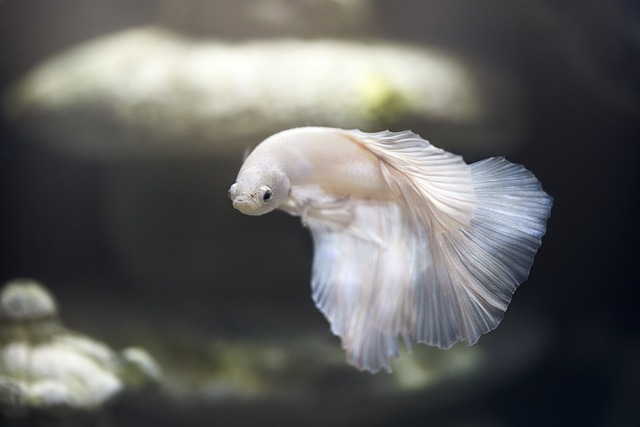Decoding the Secret World of Betta Fish Behavior
Introduction: Dive into the mesmerizing realm of betta fish, where vibrant colors and intricate behaviors captivate aquarium enthusiasts worldwide. These tiny, yet charismatic creatures harbor a complex social structure and fascinating habits that often go unnoticed. Join us as we explore the hidden depths of betta fish behavior, uncovering the secrets behind their unique personalities and interactions.

The Evolution of Betta Fish Behavior
Betta fish, scientifically known as Betta splendens, have a rich evolutionary history that has shaped their distinct behaviors. Originating in the shallow, oxygen-poor waters of rice paddies and slow-moving streams in Southeast Asia, these fish developed unique adaptations to survive in their challenging environment. One of the most remarkable features is their labyrinth organ, an auxiliary breathing structure that allows them to gulp air from the surface, enabling survival in low-oxygen conditions. This adaptation has influenced their behavior, as bettas frequently visit the water’s surface to breathe, a trait that sets them apart from many other aquarium fish.
Territorial Instincts and Aggressive Displays
Perhaps the most well-known aspect of betta fish behavior is their territorial nature, particularly among males. In the wild, male bettas stake out and fiercely defend their territories, which often span several square feet of water. This territorial instinct is deeply ingrained and persists even in captivity, where male bettas are typically kept separated to prevent aggressive encounters. When two males come into visual contact, they engage in elaborate displays of dominance, flaring their gills, spreading their fins, and intensifying their colors. These displays serve as a form of communication, allowing bettas to assert dominance without resorting to physical combat, though fights can occur if neither fish backs down.
The Art of Betta Fish Communication
Contrary to popular belief, betta fish possess a sophisticated system of communication that goes beyond mere aggression. Their vibrant colors and flowing fins serve as visual signals, conveying information about their mood, health, and intentions. For example, a betta with pale, clamped fins may be stressed or ill, while one with fully spread, vibrantly colored fins is likely feeling confident and healthy. Bettas also use body positioning and movements to communicate. Vertical bar patterns that appear on their bodies can indicate stress or submission, while horizontal stripes often signal aggression or readiness to spawn.
Courtship and Breeding Behaviors
The courtship rituals of betta fish are among the most fascinating aspects of their behavior. When a male betta is ready to breed, he constructs an intricate bubble nest at the water’s surface, using his saliva to create a floating matrix of bubbles. This nest-building behavior is instinctive and can occur even in the absence of females, serving as a sign of the male’s health and readiness to reproduce. During courtship, males perform elaborate dances, flaring their fins and circling the female. If receptive, the female will respond with her own displays, leading to a complex spawning process where the male wraps around the female to fertilize her eggs. After spawning, the male takes on the role of caregiver, carefully placing the eggs in the bubble nest and guarding them until they hatch.
Cognitive Abilities and Learning
Recent research has begun to shed light on the cognitive abilities of betta fish, revealing that these small creatures are capable of more complex behaviors than previously thought. Studies have shown that bettas can recognize individual humans and even distinguish between different shapes and colors. They exhibit problem-solving skills when navigating their environment and can be trained to perform simple tasks using positive reinforcement techniques. This cognitive flexibility suggests that betta fish possess a level of intelligence that allows them to adapt to various situations, both in the wild and in captivity.
Environmental Influences on Betta Behavior
The environment in which betta fish live plays a crucial role in shaping their behavior. In captivity, factors such as tank size, water quality, temperature, and the presence of tank mates can significantly influence a betta’s mood and actions. A well-maintained, properly sized aquarium with appropriate hiding spots and enrichment can promote natural behaviors and reduce stress. Conversely, poor living conditions can lead to abnormal behaviors, such as excessive hiding, lethargy, or increased aggression. Understanding and providing for the environmental needs of betta fish is essential for their well-being and for observing their full range of natural behaviors.
In conclusion, the world of betta fish behavior is a rich tapestry of instincts, adaptations, and learned responses. From their evolutionary history to their complex social interactions, these small fish offer a fascinating glimpse into the intricacies of aquatic life. By understanding and appreciating the nuances of betta behavior, we can not only provide better care for these beloved pets but also gain insights into the broader field of animal behavior and cognition. As research continues to uncover new aspects of betta fish intelligence and social dynamics, our appreciation for these colorful creatures is sure to deepen, reminding us of the wonders that exist beneath the surface of our aquariums and in the natural world beyond.





